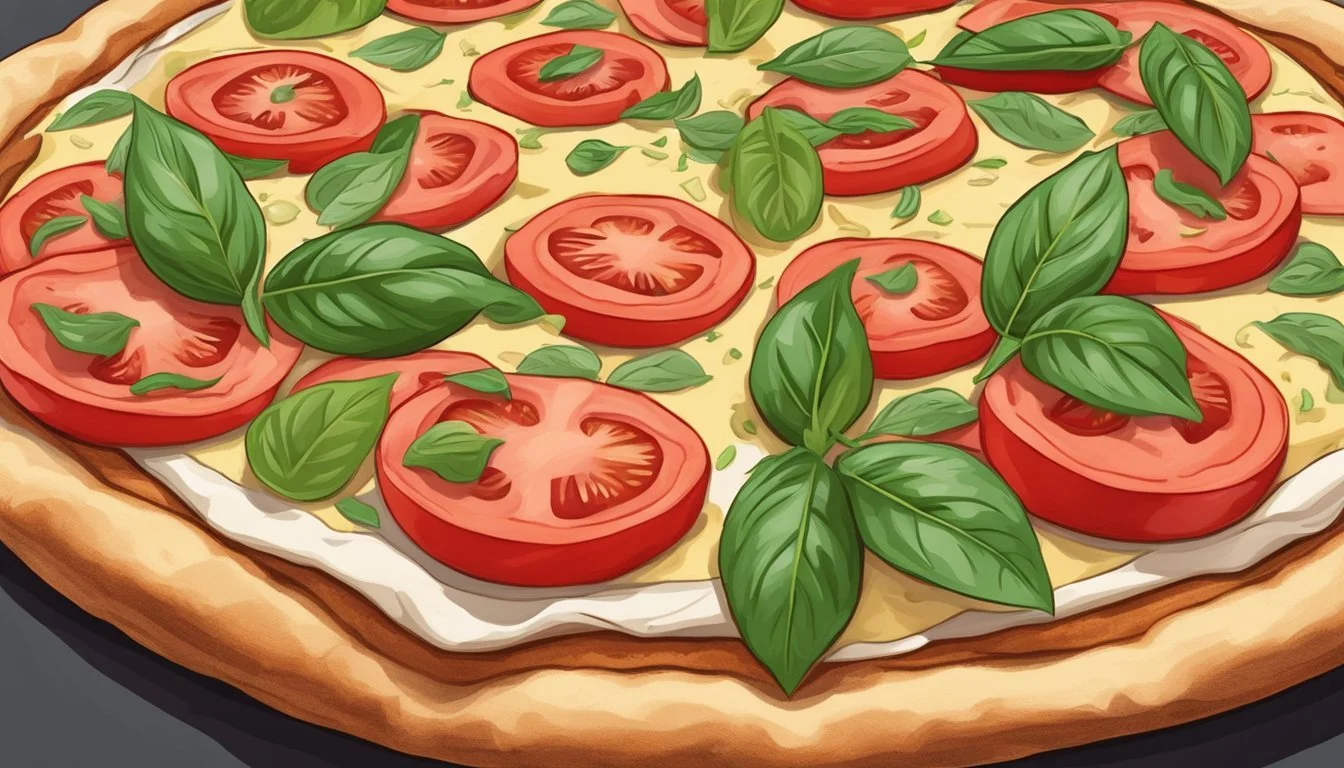Is Neapolitan Pizza Vegan?
Understanding Traditional Ingredients
Neapolitan pizza originates from Naples, Italy, and is revered for its simplicity and fresh, high-quality ingredients. Traditionally, it encompasses a thin, soft dough with a puffed-up pillowy edge, known as the 'cornicione', and is adorned with a tomato sauce, fresh mozzarella cheese, basil, and a drizzle of extra-virgin olive oil. Given these customary ingredients, classic Neapolitan pizza does not meet vegan standards due to the inclusion of mozzarella cheese, which is derived from cow's milk.
However, the rising popularity of veganism has led to adaptations of this traditional recipe, accommodating the dietary preferences that abstain from all animal products. To make a Neapolitan pizza vegan, chefs replace the dairy cheese with plant-based alternatives. These vegan substitutes aim to replicate the melting quality and mild taste of mozzarella. Vegan Neapolitan pizzas may also feature a range of vegetable toppings and the use of vegan dough, which excludes any animal byproducts, ensuring the entire dish is plant-based.
The cooking method for Neapolitan pizza is also distinctive, where the pizza is baked in an extremely hot wood-fired oven, reaching high temperatures that cook the pizza rapidly and imbue it with a characteristic char. Vegan Neapolitan pizzas benefit from the same cooking process, achieving a similar texture and flavor profile as their non-vegan counterparts. With the correct substitutes and cooking techniques, Neapolitan pizza can be enjoyed in a form that aligns with a vegan lifestyle without compromising on the traditional qualities that make this style so beloved.
Understanding Neapolitan Pizza
Neapolitan pizza, a culinary creation synonymous with Naples, Italy, is recognized for its precise ingredients and traditional preparation methods. The recipe's authenticity is safeguarded by strict regulations that ensure each pizza embodies the taste of its historic origins.
History and Origin
Neapolitan pizza, or Pizza Napoletana, finds its roots in Naples, where it transformed from a simple, accessible food for the poor to a culinary phenomenon embraced worldwide. Its beginnings date back to the 18th century when it was commonly served to visitors as a testimony to the region’s flavors. The essence of Naples is captured through signature local ingredients, such as Mozzarella di Bufala Campana, a cheese made from water buffalo milk which is native to the Campania region, and Pomodorino del Piennolo del Vesuvio, a small, flavor-packed tomato grown in the mineral-rich volcanic soil surrounding Mount Vesuvius.
Key Characteristics
Neapolitan pizza is distinguishable by its crust, thin in the middle and puffed up around the edges, known as the "cornicione". The crust is crafted from a simple yet specific dough made from type "00" wheat flour, fresh yeast, water, and salt. A key characteristic of this pizza is the Neapolitan Pizza Dough that requires kneading into a smooth, elastic texture and undergoing precise fermentation periods.
Tomato Sauce: Typically, a raw, uncooked sauce that consists of crushed Pomodorino del Piennolo del Vesuvio tomatoes seasoned subtly with salt.
Cheese: As per tradition, only Mozzarella di Bufala Campana is employed to achieve an authentic flavor.
Oven: Baking Neapolitan pizza in a wood-fired oven at temperatures reaching approximately 485°C (905°F) is non-negotiable. This high temperature ensures the pizza cooks rapidly, often in under 90 seconds, and imparts a distinct char.
The marriage of these elements culminates in what is officially recognized as Naples-Style Pizza, where the simplicity of premium ingredients harmonizes with ancestral techniques, delivering a slice that is deeply ingrained in the legacy of Naples and Italian culinary culture.
The Basics of Veganism
Adopting a vegan diet is both a dietary choice and a lifestyle commitment. Individuals choose veganism for various reasons, including ethical concerns, health considerations, and environmental factors. The focus is on plant-based foods that exclude all forms of animal exploitation and cruelty.
Principles of Vegan Diet
A vegan diet eliminates all animal products, including meat, dairy, and eggs. It is rich in whole foods, comprising fruits, vegetables, legumes, nuts, and seeds. Protein needs are met through plant-based sources such as beans, lentils, tofu, and tempeh. Notably, a well-planned vegan diet is adequate in essential nutrients, though attention is needed to select foods high in fiber, vitamins, and minerals.
Some staples of a vegan diet displayed in a typical menu might include:
Breakfast: Oatmeal with almond milk, chia seeds, and fresh berries
Lunch: Quinoa salad with chickpeas, mixed greens, and an extra virgin olive oil dressing
Dinner: Stir-fried tofu with a variety of vegetables and brown rice
Common Vegan Substitutes
To replicate the tastes and textures that animal products provide, vegans use a range of substitutes. Vegan cheese can be made from nuts, soy, or root vegetables and is often fortified with vitamin B12. Vegan pepperoni is commonly crafted from seitan (What wine goes well with seitan?) or tofu and seasoned with a mixture of spices to imitate the flavor profile of traditional pepperoni. Table 1 presents some typical substitutes for their non-vegan counterparts:
Non-Vegan Ingredient Vegan Substitute Cheese Nutritional yeast, vegan cheese Pepperoni Vegan pepperoni (seitan, tofu) Butter Olive oil, coconut oil
In conclusion, veganism is about choosing alternatives that align with a cruelty-free and environmentally sustainable lifestyle, and modern culinary innovations have made it possible to enjoy traditional flavors in new, plant-based ways.
Is Traditional Neapolitan Pizza Vegan?
Traditional Neapolitan pizza hails from Naples, Italy, and is known for its specific preparation technique and high-quality ingredients. This iconic pizza does not align with a vegan diet as the classic recipe includes dairy-based cheese, specifically Mozzarella di Bufala Campana, which is made from the milk of water buffalo.
The dough of Neapolitan pizza is simple, comprising flour, water, salt, and yeast, making it vegan by default. However, the issue arises when considering the toppings. Traditional Neapolitan pizza toppings may not be vegan-friendly, primarily due to the inclusion of Mozzarella cheese and sometimes other non-vegan ingredients such as anchovies.
To cater to vegan preferences, Vegan Neapolitan Pizza substitutes dairy cheese with plant-based alternatives. Various vegan cheeses are available that mimic the taste and texture of Mozzarella to create a vegan-friendly version without compromising on the traditional flavor profile.
The table below provides a basic comparison:
Traditional Neapolitan Pizza Vegan Neapolitan Pizza Mozzarella di Bufala Campana Plant-based Mozzarella Non-vegan add-ons (if any) Vegan add-ons Dairy-based Dairy-free
In summary, while a traditional Neapolitan pizza is not vegan due to the cheese used, it can be adapted to fit a vegan lifestyle with appropriate substitutions for the cheese and careful selection of toppings.
Making Vegan Neapolitan Pizza
Crafting an authentic Neapolitan pizza with a vegan twist involves preparing a simple, yet specific, yeast-leavened dough and selecting plant-based toppings and cheese. The cooking technique retains the traditional high-heat baking that gives Neapolitan pizza its characteristic char and chew.
Vegan Neapolitan Pizza Dough
Neapolitan pizza dough is characterized by its tender crust, achieved with a high-hydration mix of Flour 00 or bread flour, water, yeast, and sea salt. For a vegan version, it's crucial to ensure that the yeast is not derived from animal sources. Mix the yeast with water and let it activate, which typically creates a bubbling effect. Then, combine this with flour—preferably Caputo Flour for authenticity—and salt. Some recipes might add a pinch of sugar to support yeast activity. The dough should then rise overnight, followed by an additional raise for a few hours after shaping into balls.
Choosing Vegan Toppings
Vegan toppings for Neapolitan pizza should incorporate bold flavors to mimic the richness traditionally provided by cheese. Vegan cheese options can include homemade cashew cheese or store-bought varieties that melt well. Tomato sauce acts as the base, and should be simple and vibrant, made from pureed tomatoes seasoned with fresh basil, oregano, and garlic. Additional toppings might include a variety of vegetables, olive oil, and red pepper flakes for an added kick.
Vegan Cooking Techniques
The quintessential blistered crust of Neapolitan pizza comes from cooking at high temperatures, around 390 Fahrenheit (200 degrees Celsius), which is still applicable for vegan pizzas. Use parchment paper on a baking tray to handle the dough and prevent sticking. Bake for approximately 12-15 minutes or until the crust turns golden brown and vegan cheese has melted. For a bubbly crust, do not press down the edges while shaping. After baking, garnish with fresh basil leaves, a drizzle of olive oil, and a pinch of sea salt and red pepper flakes to enhance flavor.
Vegan Neapolitan Pizza Recipes
Creating vegan Neapolitan pizza is simple with the right ingredients such as substitute vegan cheese and a variety of plant-based toppings. These recipes cater to both traditional and gluten-sensitive pizza lovers.
Classic Vegan Neapolitan Pizza
Ingredients:
Pizza Dough: A traditional Neapolitan pizza dough can easily be made vegan by using fresh yeast, flour, water, salt, and extra virgin olive oil (evo).
Tomato Sauce: A pure blend of tomatoes, seasoned with salt and oregano to taste.
Vegan Cheese: Choose from store-bought varieties or make your own.
Toppings: Fresh basil leaves and vegan pepperoni or other plant-based toppings as desired.
Instructions:
Start by preparing the dough. Mix water and fresh yeast, then gradually add flour. Once mixed, incorporate salt and evo oil, and let the dough rise overnight.
The next day, fold the dough into a ball and allow it to rise for an additional 3 hours.
Preheat oven to 390°F (200°C).
Shape the dough on a tray lined with parchment paper, creating a thin layer for the base.
Spread tomato sauce evenly across the dough, leaving the edges slightly higher for a traditional crust.
Apply vegan cheese and preferred toppings.
Bake until the crust is golden brown, approximately 12-15 minutes, and finish with a sprinkle of fresh basil leaves.
Gluten-Free Vegan Neapolitan Pizza
Ingredients:
Gluten-Free Pizza Crust: A blend of gluten-free flours like rice flour or gluten-free all-purpose flour with water, fresh yeast, and salt.
Tomato Sauce: As described in the classic recipe.
Vegan Cheese: Complementary to the gluten-free crust.
Toppings: Fresh basil leaves, oregano, and optional vegan pepperoni.
Instructions:
For the gluten-free crust, combine gluten-free flour with water, fresh yeast, and salt, mixing until a soft dough forms.
Allow the dough to rise as with the classic dough.
Preheat the oven to 390°F (200°C).
Carefully stretch the gluten-free dough onto a parchment paper-lined tray.
Top with a thin layer of tomato sauce, avoiding overflowing the crust edges.
Sprinkle with vegan cheese, fresh basil leaves, oregano, and any additional toppings.
Bake until the edges are crispy and the toppings are cooked through, typically 12-15 minutes.
Cooking Equipment
The quality and authenticity of Neapolitan pizza can be greatly affected by the cooking equipment used. Selecting the right tools is vital for achieving the traditional char and crust characteristic of Neapolitan-style pizza.
Pizza Ovens
Neapolitan pizza traditionally requires a wood-fired oven which can reach temperatures of up to 800 degrees Fahrenheit (425 degrees Celsius). This high heat is crucial for cooking the pizza quickly, often in 90 seconds or less, and creating the classic blistered crust. A pizza oven should also distribute heat evenly; hence, many models come equipped with a pizza stone or iron pizza stone to replicate the base heat of a commercial wood-fired oven.
Alternative Cooking Methods
For home chefs without access to a wood-fired oven, a regular oven can suffice with the aid of a pizza stone in the oven. It should be preheated at the highest temperature possible for around 30 to 60 minutes to ensure the stone is correctly heated. Pizza stones effectively mimic the cooking surface of professional ovens by absorbing moisture and distributing heat evenly to the dough.
Additional Tools
Neapolitan pizza dough typically requires mixing and kneading which can be achieved with a mixer. More specifically, a stand mixer with a dough hook attachment is preferred for consistent results. A large mixing bowl is essential for dough proofing. Additionally, a kitchen scale is crucial for measuring ingredients with precision. For transferring the pizza into and out of the oven, a baker’s peel is highly recommended – it helps to safely place the pizza directly onto the preheated stone and retrieve it with ease.
Using these specialized tools will equip any chef with the means to craft an authentic Neapolitan pizza experience.
Storing and Reheating
Storing Neapolitan pizza properly is crucial to maintaining its taste and texture, while reheating it correctly is key to enjoying a slice that's as close to fresh as possible.
Preserving Leftovers
When preserving Neapolitan pizza leftovers, one should place slices in an airtight container before storing them in the refrigerator. If an individual plans to keep the pizza for longer than a couple of days, freezing is a viable option. To freeze Neapolitan pizza, wrap each slice tightly in plastic wrap or foil, and place it in an airtight container or a freezer bag.
Reheating Pizza for Best Results
To ensure the leftovers remain crispy when reheated, remove the pizza from the airtight container and let it sit at room temperature while preheating the oven. For a homemade pizza, using a preheated oven at approximately 375°F (190°C) is advisable. Place slices directly on a wire rack in the center position of the oven for even heating, and check periodically until the desired warmth is reached. Avoid overheating, as this can compromise the texture and flavor of the pizza.
Vegan Neapolitan Pizza FAQs
Is traditional Neapolitan pizza vegan?
Traditional Neapolitan pizza may contain non-vegan ingredients like cheese. However, the basic components of the crust—flour, water, salt, and yeast—are naturally vegan.
What kind of yeast is used in vegan pizza dough?
Vegan pizza dough can be made with different types of yeast, including active dry yeast or fresh yeast. Proofing time may vary based on the yeast used, with fresh yeast generally requiring less time.
How does one proof vegan pizza dough effectively?
Effective proofing is essential for a light and fluffy crust. First, let the dough rest overnight in a cool environment. Then allow it to rise again for a few hours, ensuring the dough reaches the right consistency.
Can vegan pizza dough create a thin crust?
Absolutely. To achieve a thin crust, one must stretch the dough carefully and uniformly, allowing for a crispy base once baked.
What kind of oven is suitable for vegan Neapolitan pizza?
A very hot oven is ideal. Traditional stone ovens are used for authentic Neapolitan pizza, but a home oven preheated to around 450-500°F (232-260°C) can work for a vegan version.
Does vegan Neapolitan pizza have a fluffy crust?
To attain a fluffy crust, one should not depress the edges while shaping the dough. The edges will rise and bubble up to create the signature Neapolitan pizza crust.
Can toppings affect the vegan status of Neapolitan pizza?
Yes, all toppings must be plant-based to maintain a vegan status. Traditional toppings like cheese need to be substituted with vegan alternatives.
Lifestyle and Budget Considerations
Navigating the world of vegan diets and family traditions such as pizza nights can be balanced effectively with smart planning and budget-friendly strategies.
Family Pizza Night
For those who want to maintain the tradition of pizza night while adhering to a vegan lifestyle, homemade pizza is an ideal solution. They can control ingredients, customizing toppings to meet every family member's preferences. Preparing pizza dough from scratch is cost-effective, and when families invest in bulk purchases of flour and yeast, they further reduce the cost per pizza. Utilizing vegan cheese substitutes or nutritional yeast adds the desired cheesy flavor without the dairy.
Ingredients for Family Pizza Night:
Flour: For the base
Yeast: To make the dough rise
Vegan Cheese: For a dairy-free cheese experience
Toppings: Vegetables and vegan proteins to taste
Sauce: Tomato or other vegan-friendly options
By creating homemade pizza, families introduce children to cooking, which is an engaging activity and an opportunity to talk about nutrition and the benefits of a plant-based diet.
Vegan Pizza on a Budget
Creating a vegan pizza on a budget is achievable through several money-saving tips. Shoppers should look for deals and discounts on plant-based toppings and vegan cheese alternatives. Buying ingredients in bulk or opting for seasonal vegetables can further reduce expenses. Budget recipes often substitute expensive items with more affordable, yet equally nutritious, options. For instance, instead of specialty vegan cheeses, one can use a homemade cashew cheese sauce, which is a cost-effective and healthy alternative.
Budget-Friendly Vegan Pizza Tips:
Sauce: Tomato paste mixed with herbs instead of pre-made sauces
Cheese: Nutritional yeast or homemade cashew cheese instead of store-bought vegan cheese
Toppings: Seasonal vegetables, canned goods, and bulk-purchased items
Sticking to a budget does not mean sacrificing flavor or quality. With careful planning and a little creativity, vegan pizza becomes a delightful and affordable meal that aligns with a vegan-friendly lifestyle.








